In Segment 3 of CCJ’s three-part report on PSM’s 16th annual meeting, users recount experiences with 501F, 7EA technology upgrades
This is the third and final segment of CCJ’s report on PSM’s 2024 Asset Management Conference, conducted at the Westin Beach Resort, in Fort Lauderdale, Fla, January 29-February 1. Segment One appeared in CCJ No. 78, pp 58-63, Segment Two in CCJ No. 79, pp 81-87.
Focus here is on the comprehensive suite of products and services, including PSM’s well-known GTOP and FlameSheet™ brands, available for the 501F machine (Fig 1), a technology development effort begun a decade and a half ago, including two presentations on field experience from two of the largest gas- turbine/combined-cycle owner/operators in the country. A third user presentation reviews experience with a 7EA upgrade.
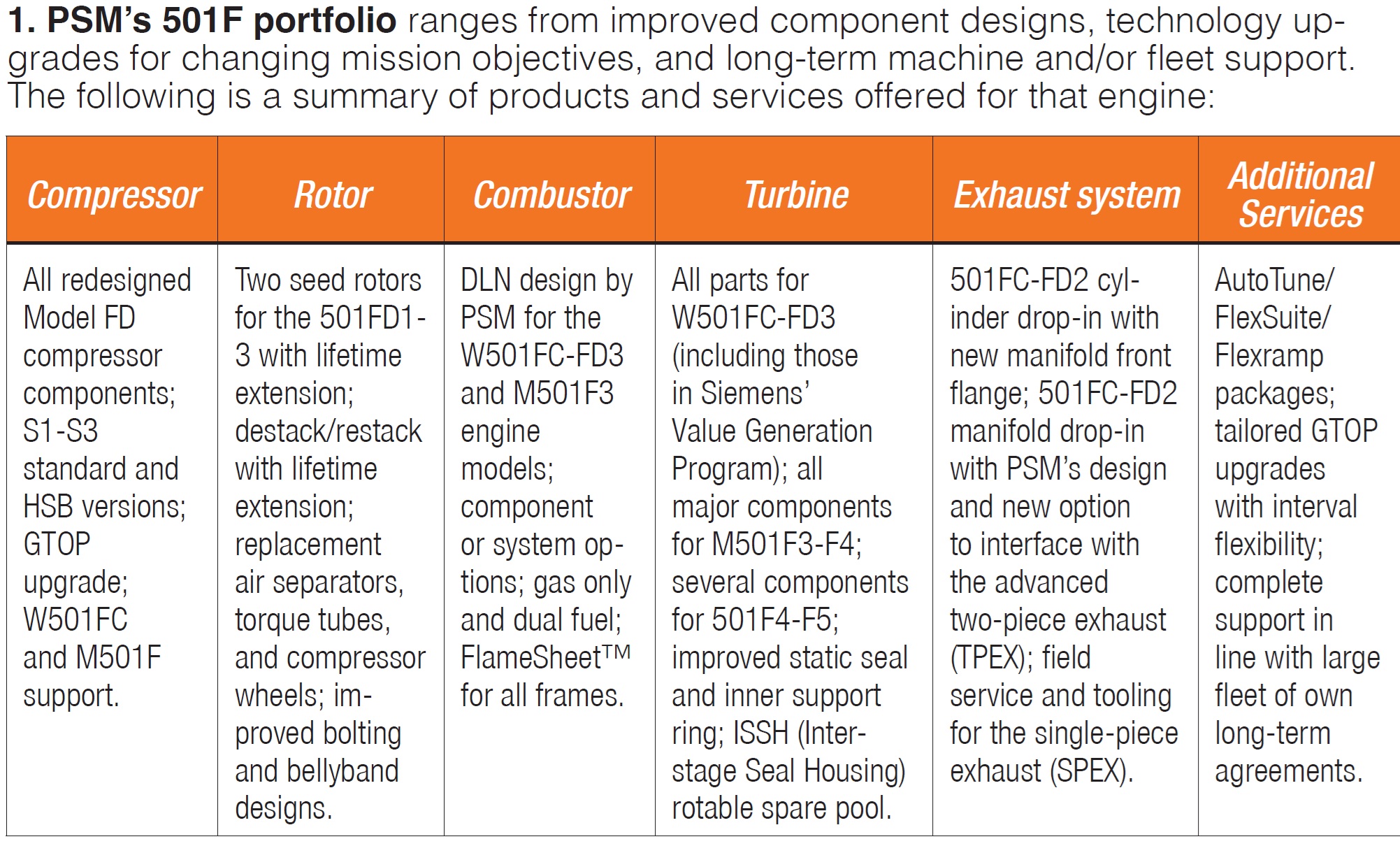
From a high level, the various 501F GTOP versions offer output increases of between 8 and 20 MW and heat rate improvements from -2.5% to -3.8%. Soon, GTOP (with FlameSheet™ Gen VII) will be achieving sub-30% turndown. Total number of 501F hot-gas-path (HGP)/compressor upgrades performed by PSM: 24.
If it is operating flexibility you are after, the company has options across the machine (Fig 2) including in addition to GTOP, the FlameSheet combustor, inlet bleed heat (IBH), exhaust bleed (ExB), wet compression, and digital logic. ExB, in particular, can achieve up to 10% better turndown, and can be coupled with separate or integrated anti-icing capability with no modifications to the filter housing.
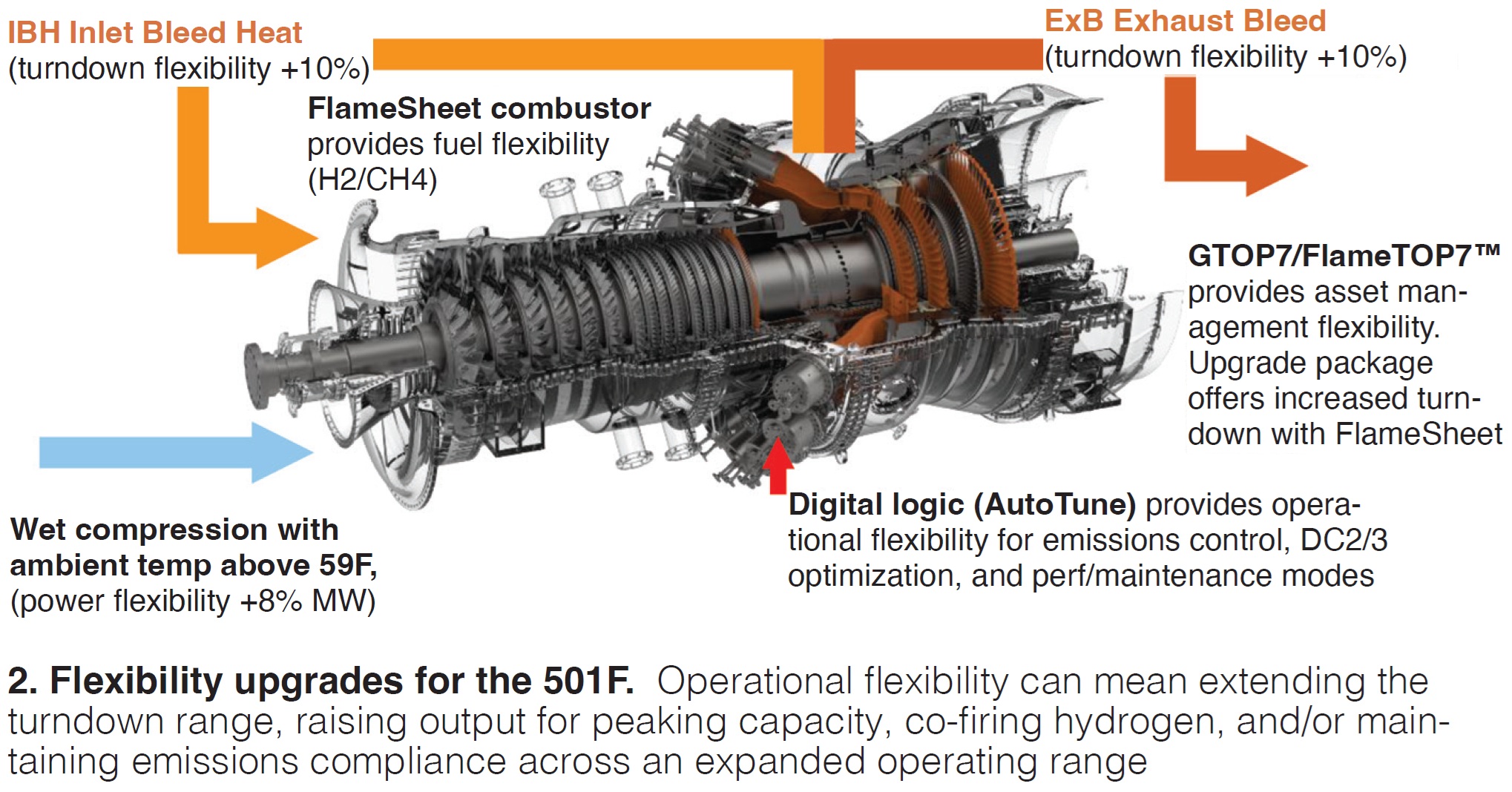
Ultimate flexibility comes in the form of the FlameTOP 7 upgrade, a combination of GTOP and the FlameSheet™ combustor. The three general operating modes are the following:
- Maintenance—32k hours, 9% simple cycle (SC) power boost, and 3.4% better heat rate.
- Performance mode—24k hours, up to 12% SC capacity boost, and 3.8% better heat rate.
- Peak mode—up to 13.6% SC power boost, and 3.8% heat-rate improvement. All of these improvements are possible without sacrificing a 9-ppm NOx emissions limit across the load range.
And PSM isn’t stopping there. The next generation of GTOP (Fig 3) is incorporating FlameSheet™ Gen VII (FlameTOP7), plus new alloys for better resistance to low-cycle fatigue and creep, and additive manufacturing, and other techniques to speed up production capabilities. Uniform crystal temperature sensors embedded in TBC coated parts have validated lower metal temperatures in AM parts made using the latest techniques.
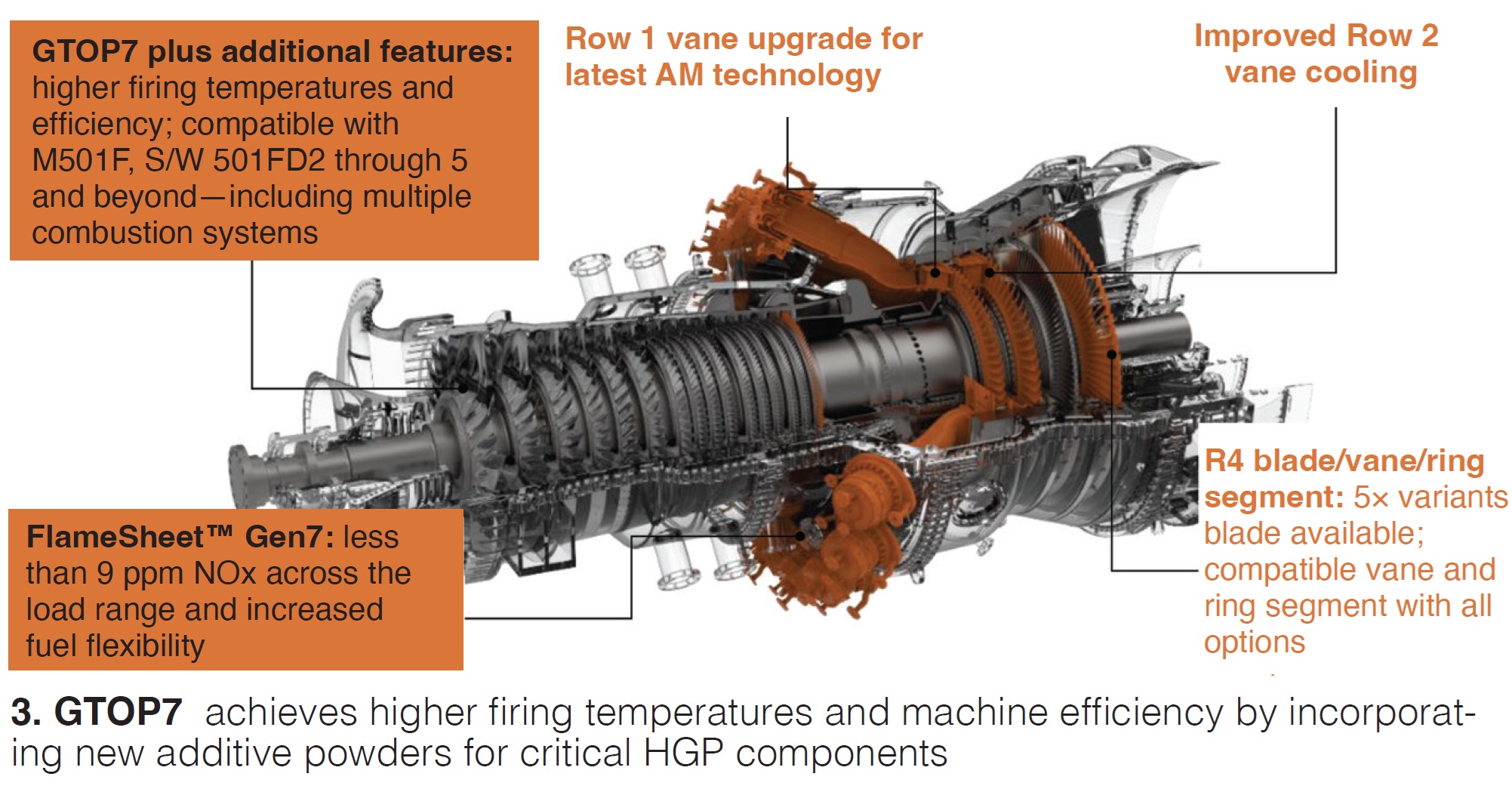
The first repair cycle of the next-gen GTOP7 first-stage vanes from the fleet leader’s machine surpassed 25k factored fired hours (FFH) with minimal distress. Check out the photos in Fig 4 to see how the vanes looked coming out for inspection and repair. Overall, AM-produced vanes have been installed in over 13 machines with 132k operating hours and 2200 fired starts.

Duke Energy, Osprey Energy Center. As relayed by Jim Guevara, operations superintendent for Osprey Energy Center, and PSM’s Chris Hagger, senior project manager, the plant needed more peak megawatts and minimum load adjustments to respond to the grid’s summer morning solar output surges and afternoon solar dropoffs caused by thunderstorms. In the winter, the plant has to respond to high morning demand and lags in solar output.
Other goals of the GTOP7 and FlameSheet™ upgrade include keeping the GTs and ST/G online to maintain high availability, reduce dependence on the duct burners, improve heat rate, and extend low-end performance. Upgrade also included ExB, IBH, controls logic with disc-cavity modulation, AutoTune for maintaining emissions limits, refurbished rotor, and first-of-its-kind single-piece exhaust tooling.
Osprey is a 2 × 1 combined cycle with two Siemens 501FD2 GTs, a Siemens KN steamer, and Nooter Eriksen HRSGs. After going commercial in May 2004, each of the GTs units has incurred more than 2400 starts and the ST/G more than 1900 starts.
After project completion, the plant tops out at 576 MW+ (up from 537 MW), over 600 MW with PAG and duct firing enabled, and turns down to 235 MW with IBH and ExB (from the earlier limit of 380 MW). This is a total of an operating range of 365 MW, all while holding sub-9 ppm NOx. To achieve the turndown levels, the ExB Flexline connectors (from the injection manifold to the bleed injectors) had to be replaced which came at a later outage and is now fully enabled on both units.
Major project activities and schedule (Fig 5) suggest the importance of the pre-outage planning phase, but of particular note is that the actual unit outages were 80 and 84 days with 10-15 days required for commissioning and startup.
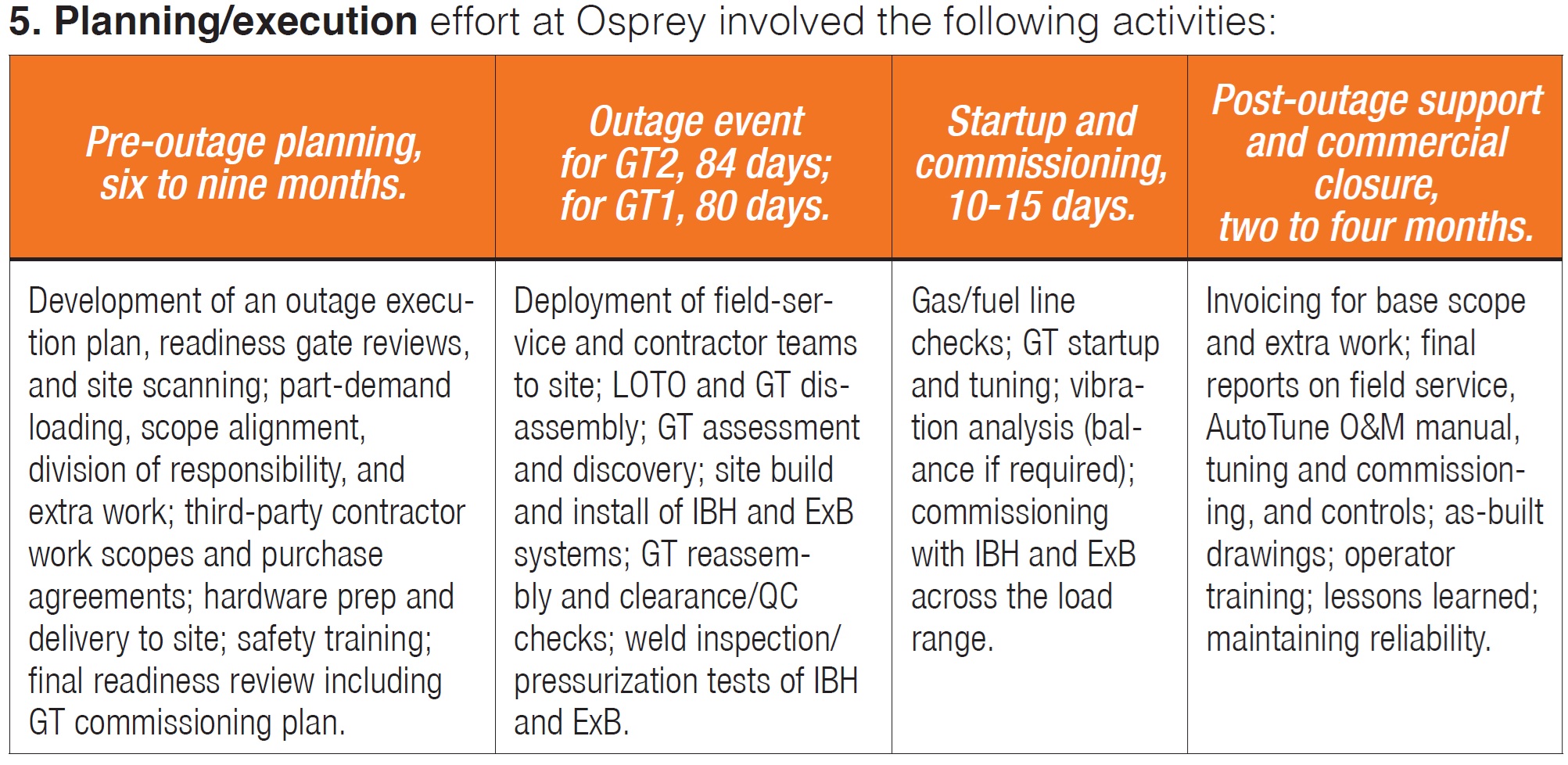
Observations and lessons learned include the following:
- Close coordination is essential between dispatch and plant to comply with air permits during commissioning.
- The IBH manifold is best placed downstream of the duct silencer to reduce noise.
- The NH3 valve had to be re-trimmed by the valve OEM for lower reagent flows.
- Igniters demonstrated high reliability.
To date, Osprey is enabling the lowest turndown the plant can achieve most nights, changing the operating profile from the prior heavy starts operation to being able to remain online for quicker grid response.
Rocky Mountain Energy Center. Jeff Hall, Xcel Fleet Engineering Turbine Div, and Jose Ruiz, PSM’s director of project execution, explained how the scheduled outage for Rocky Mountain (2 × 1, two 501Fs, one KN steam turbine) to install the FlameTOP upgrade revealed several other issues which had to be addressed: ST/G coupling alignment, need for a 4-way joint Superbolt™ solution, significant wear on hookfits, bearing damage, foreign object damage (FOD) on blades and diaphragms, and bearing damage.
Like many other system owner/operators, Xcel needed more dispatchable power from RMEC to follow its wind resources, but also wanted to extend inspection intervals from 24k to 32k, reduce ammonia consumption, and be prepared for future hydrogen co-firing. The presenters note that the key HGP upgrade within the project scope (Fig 6) was the additive manufactured R1 vane, which reduces cooling airflow.
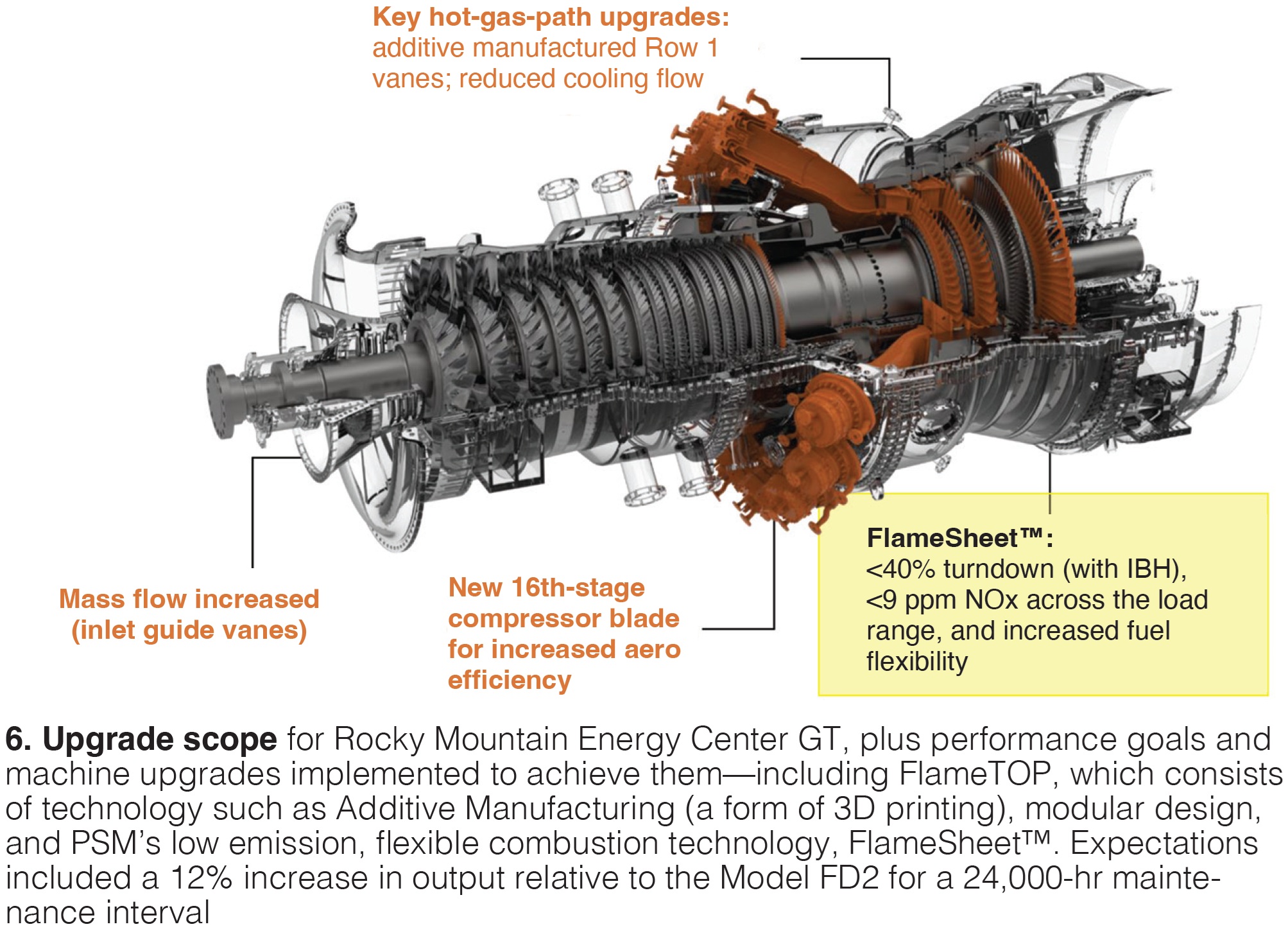
The project achieved the stretch capacity goal (160 MW) for both units, a 1.62% heat-rate improvement, and turndown to 50MW in Unit 1 and 45 MW in Unit 2 (with IBH and ExB). However, while both units are available, PSM and the plant were resolving emissions-performance issues with Unit 1. Distress found with some of the new hardware led to replacement of some parts and aggressive tuning efforts. This has since been resolved and both units are currently operating at sub-9 ppm NOx.
Included in lessons learned and observations are: Every unit is unique (with exclamation point), hookfit repair was challenging, pay attention to routing and securing thermocouple leads, carefully consider IBH positioning with respect to the silencers, and assess and understand the potential limitations of the BOP.
To close, PSM thanked Xcel Energy for this latest chapter in the 10+ year partnership between the two companies, which began with long-term parts exchange agreements and includes PSM support in more than 25 outages, and an extension of their agreement covering Xcel’s 7FA simple-cycle units.
Rawhide station. Platte River Power Authority’s Rawhide station includes four 7EAs and one 7FA for a combined 388 MW, 288-MW coal-fired unit, and 52-MW nameplate solar PV (22 MW effective capacity). Upgrade goal here, described in a qualitative way, is to allow the 7EAs to participate in the market “like aeros can.” Practically, that means greater sustainable load range, reduced emissions, and lower O&M costs. Low-emissions combustor (LEC) NextGen (replacing a DLN 1), sequential fuel injection (SFI), and AutoTune checked those boxes and Platte River decided to upgrade one unit.
The financial impact was considerable: The plant expects to save over $1-million in O&M costs over the course of a major outage interval. Essentially, the LEC NextGen avoids the combustor inspection (CI) at 12k OH/600 starts before the HGP (at 24k/1200 starts), and the CI at 44k/1800 starts before the major outage overhaul at 64k/2400 starts.
The unit not only exhibits lower emissions but is also now able to come into compliance earlier. The previous unit load range was 40-65MW; following the upgrade, it is 27-70 MW. No other performance attributes, such as heat rate, were sacrificed in attaining these goals.
Exhibits. The 2024 Asset Managers Conference was the first time PSM invited participation of their “partner” specialty product and services providers to the meeting. Here’s a list of those companies:

- AGT Services.
- Vogt Power International.
- Advanced Turbine Support (Fig 7).
- Arnold Group.
- Mee Industries.
- National Electric Coil.
- Power Services Group.
- NexGEN.
- Alta Solutions.
- Industrial Air Flow Dynamics.
- Emerson.
- RMEC Environmental.
- Integrity Power Solutions.
- Hanwha Power Systems.
- PSM Thomassen Gulf.






